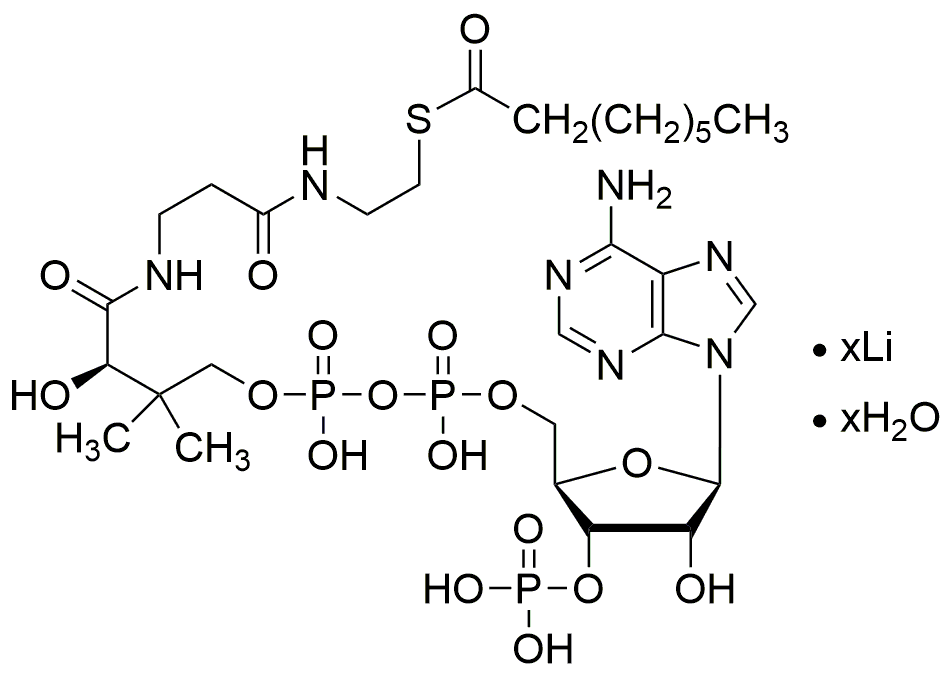Octanoyl coenzyme A lithium salt hydrate is widely utilized in research focused on:
- Metabolic Studies: This compound plays a crucial role in fatty acid metabolism, allowing researchers to study energy production and lipid synthesis in various biological systems.
- Biochemical Pathway Analysis: It serves as a key intermediate in metabolic pathways, enabling scientists to investigate the biochemical processes involved in cellular functions and disease mechanisms.
- Drug Development: The compound is used in the formulation of pharmaceuticals targeting metabolic disorders, providing a foundation for developing new therapeutic strategies.
- Food Industry Applications: It can be explored for its potential in enhancing flavor profiles and nutritional value in food products, appealing to health-conscious consumers.
- Cosmetic Formulations: The compound's properties make it suitable for use in skincare products, where it can aid in skin hydration and nourishment, attracting the attention of cosmetic formulators.
Informations générales
Propriétés
Sécurité et réglementation
Applications
Octanoyl coenzyme A lithium salt hydrate is widely utilized in research focused on:
- Metabolic Studies: This compound plays a crucial role in fatty acid metabolism, allowing researchers to study energy production and lipid synthesis in various biological systems.
- Biochemical Pathway Analysis: It serves as a key intermediate in metabolic pathways, enabling scientists to investigate the biochemical processes involved in cellular functions and disease mechanisms.
- Drug Development: The compound is used in the formulation of pharmaceuticals targeting metabolic disorders, providing a foundation for developing new therapeutic strategies.
- Food Industry Applications: It can be explored for its potential in enhancing flavor profiles and nutritional value in food products, appealing to health-conscious consumers.
- Cosmetic Formulations: The compound's properties make it suitable for use in skincare products, where it can aid in skin hydration and nourishment, attracting the attention of cosmetic formulators.
Documents
Fiches de données de sécurité (FDS)
La FDS fournit des informations de sécurité complètes sur la manipulation, le stockage et l’élimination du produit.
Spécifications du produit (PS)
Le PS fournit une description complète des propriétés du produit, notamment sa composition chimique, son état physique, sa pureté et les exigences de stockage. Il détaille également les plages de qualité acceptables et les applications prévues du produit.
Certificats d'analyse (COA)
Recherchez des certificats d'analyse (COA) en saisissant le numéro de lot du produit. Les numéros de lot et de lot se trouvent sur l'étiquette d'un produit, après les mots « Lot » ou « Lot de fabrication ».
Numéro de catalogue
Numéro de lot/série
Certificats d'origine (COO)
Ce certificat d'exploitation confirme le pays dans lequel le produit a été fabriqué, et détaille également les matériaux et composants utilisés et s'il est issu de sources naturelles, synthétiques ou autres sources spécifiques. Ce certificat peut être requis pour les douanes, le commerce et la conformité réglementaire.
Numéro de catalogue
Numéro de lot/série
Fiches de données de sécurité (FDS)
La FDS fournit des informations de sécurité complètes sur la manipulation, le stockage et l’élimination du produit.
DownloadSpécifications du produit (PS)
Le PS fournit une description complète des propriétés du produit, notamment sa composition chimique, son état physique, sa pureté et les exigences de stockage. Il détaille également les plages de qualité acceptables et les applications prévues du produit.
DownloadCertificats d'analyse (COA)
Recherchez des certificats d'analyse (COA) en saisissant le numéro de lot du produit. Les numéros de lot et de lot se trouvent sur l'étiquette d'un produit, après les mots « Lot » ou « Lot de fabrication ».
Numéro de catalogue
Numéro de lot/série
Certificats d'origine (COO)
Ce certificat d'exploitation confirme le pays dans lequel le produit a été fabriqué, et détaille également les matériaux et composants utilisés et s'il est issu de sources naturelles, synthétiques ou autres sources spécifiques. Ce certificat peut être requis pour les douanes, le commerce et la conformité réglementaire.


